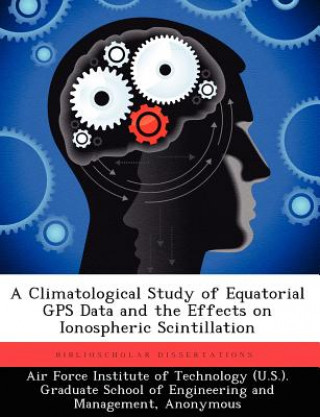
Kod: 08133903
Climatological Study of Equatorial GPS Data and the Effects on Ionospheric Scintillation
Autor Katharine A Wicker
Ionospheric scintillation is detrimental to radio signals, especially those from the global positioning system. Such scintillation is caused when a signal permeates the ionosphere through plasma bubbles. The signal's phase and amp ... więcej
- Język:
 Angielski
Angielski - Oprawa: Miękka
- Liczba stron: 72
Wydawca: Biblioscholar, 2012
- Więcej informacji o książce

Zobacz książki o podobnej tematyce
-

Adult Learning: a Reader
54.59 € -

Works of Tibullus, Containing His Love-Elegies. Translated by Mr. Dart. to Which Is Added, the Life of the Author; With Observations on the Original D
39.97 € -

Considerations Upon the Different Modes of Finding Recruits for the Army.
16.35 € -4 % -

Tillich
74.42 € -

Salopia Antiqua, or an enquiry from personal survey into the Druidical, Military, and other early remains in Shropshire and the North Welsh Borders. W
40.17 € -

Secrets
22.38 € -

Reason to Show Up for Work Tomorrow Morning
11.54 €
Podaruj tę książkę jeszcze dziś
- Zamów książkę i wybierz "Wyślij jako prezent".
- Natychmiast wyślemy Ci bon podarunkowy, który możesz przekazać adresatowi prezentu.
- Książka zostanie wysłana do adresata, a Ty o nic nie musisz się martwić.
Więcej informacji o Climatological Study of Equatorial GPS Data and the Effects on Ionospheric Scintillation
Za ten zakup dostaniesz 172 punkty
 Opis
Opis
Ionospheric scintillation is detrimental to radio signals, especially those from the global positioning system. Such scintillation is caused when a signal permeates the ionosphere through plasma bubbles. The signal's phase and amplitude can be altered, and a receiver on the ground can lose lock on the GPS signal. Measured using a zero to one index known as S4, scintillation severity is based upon season, solar cycle, time of day, location and frequency. The most severe scintillation occurs at the equatorial anomaly, or fifteen degrees north and south of the equator. Seven years of data from fifteen different locations around the equator were used in a Matlab program to determine if the current trends still apply. Previous research has found the S4 at the equator to peak during the months of September to March, between the hours of 2000 and 0300 local time, and when the sunspot number is above 60. Matlab plots were generated to find peaks in scintillation based upon location and month. These were compared to sunspot numbers during those months. A new Matlab program was made to compile all of the plots into a climatological map of the seasonal data. Trends similar to those found previously were discovered. S4 numbers peaked in the area of the anomaly, and between the months of October to March. As the sunspot number increased, the yearly average scintillation also increased. The hours of 000 to 0300 GMT also saw a peak in S4 scintillation, which agrees with previous findings. This research showed that solar maximum years, the hours of 000 to 0300 GMT, and the months of October through March have the largest amount of scintillation.
 Szczegóły książki
Szczegóły książki
Kategoria Knihy po anglicky Society & social sciences Education
69.41 €
- Pełny tytuł: Climatological Study of Equatorial GPS Data and the Effects on Ionospheric Scintillation
- Autor: Katharine A Wicker
- Język:
 Angielski
Angielski - Oprawa: Miękka
- Liczba stron: 72
- EAN: 9781249400912
- ISBN: 9781249400912
- ID: 08133903
- Wydawca: Biblioscholar
- Waga: 145 g
- Wymiary: 246 × 189 × 4 mm
- Data wydania: 17. September 2012
Ulubione w innej kategorii
-

Oxford IB Diploma Programme: IB Economics Course Book
62.26 € -

OET Preparation
10.42 € -

Cambridge IGCSE (R) & O Level Complete Physics: Student Book Fourth Edition
38.74 € -

Business Partner B2 Workbook
16.86 € -4 % -

Business Partner B1 Workbook
17.47 € -10 % -

Imagine If...
10.93 € -24 % -

OET Reading Subtest Preparation
16.86 € -

Vol 2 Blackletter Lettering Adventures
26.98 € -

AS & A Level Maths For Dummies
19.62 € -18 % -

CompTIA Security+ Review Guide - Exam SY0-601
26.37 € -20 % -

Amazing Autistic Brain Cards
42.01 € -

Hanbo Jutsu: Use of Hanbo, Cane and Walking Stick for Self Defense
11.65 € -

Embodied Teen
21.77 € -17 % -

Blue Book of Grammar and Punctuation: An Easy- to-Use Guide with Clear Rules, Real-World Examples , and Reproducible Quizzes, Twelfth Edition
16.96 € -20 % -

Positive Discipline Tools for Teachers
18.50 € -3 % -

Oxford IB Diploma Programme: IB Theory of Knowledge Course Book
57.96 € -

Oxford IB Study Guides: Economics for the IB Diploma
44.06 € -

Speed and Accuracy: Division
8.58 € -

GCSE Spanish Exam Practice Workbook (includes Answers & Free Online Audio)
7.96 € -10 % -

KS3 Maths 10-Minute Weekly Workouts - Year 7
8.07 € -9 % -

Vertical Academy
37.21 € -

Grade 9-1 GCSE Maths AQA Revision Question Cards - Higher
10.83 € -

Human Landscapes from My Country
27.90 € -4 % -

Cambridge IGCSE (R) & O Level Complete Chemistry: Student Book Fourth Edition
42.52 € -

Oxford IB Diploma Programme: IB Course Preparation Mathematics Student Book
41.09 € -

1000 TRIOS or gapped sentences for Cambridge Advanced and Proficiency Exams
25.04 € -

Business Partner B1+ Workbook
16.86 € -4 % -

(ISC) SSCP SG & SSCP Practice Test Kit, 3e
70.54 € -23 % -

Einkorn
20.75 € -21 % -

Czech Verbs
40.27 € -

Motivation and Reinforcement
46.92 € -

Pearson Edexcel International GCSE (9-1) English Language B Student Book
53.67 € -

Read Write Inc. Phonics: Red Ditty Book Bag Books (Mixed Pack of 10)
67.47 € -

Oxford International Primary Maths Second Edition: Practice Book 1
13.08 € -

Forensic Linguistics Articles
17.58 € -

Corrected Squares of The Book of Abramelin
611.20 € -

Exam Prep for Microeconomics by Pindyck & Rubinfeld, 6th Ed.
45.69 € -

KS3 Maths 10-Minute Weekly Workouts - Year 8
8.07 € -9 % -

Reading Mind - A Cognitive Approach to Understanding How the Mind Reads
24.02 € -20 % -

Internet Protocol over Link-16
69.41 € -

Effect of Registration Errors on Tracking in a Networked Radar System
69.41 € -

Princeton Review SAT Premium Prep, 2021
45.90 € -

CEH v11 Certified Ethical Hacker Study Guide + Practice Tests Set
75.44 € -5 % -

10 Practice Tests for the SAT, 2021 Edition
33.93 € -

OCP Oracle Certified Professional Java SE 11 Programmer II Study Guide - Exam 1Z0-816 and Exam 1Z0-817
49.88 € -7 % -

Prepared
33.73 € -

Powerful Teaching: Unleash the Science of Learning
28.72 € -20 % -

Physics for You
57.45 € -

Sphagnum
19.82 €
Osobný odber Bratislava a 2642 dalších
Copyright ©2008-24 najlacnejsie-knihy.sk Všetky práva vyhradenéSúkromieCookies



 21 miliónov titulov
21 miliónov titulov Vrátenie do mesiaca
Vrátenie do mesiaca 02/210 210 99 (8-15.30h)
02/210 210 99 (8-15.30h)